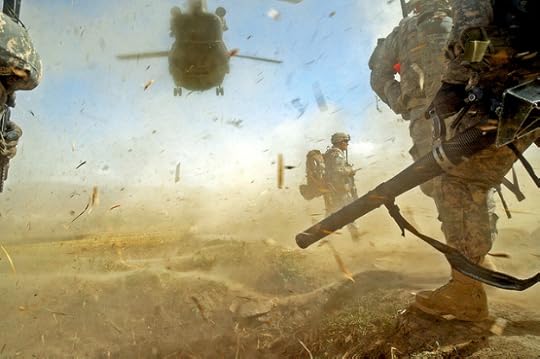Auftrag-static (III): That German stuff sounds great, until you're trying to run a U.S. Army brigade in Afghanistan…

By Maj. Niel Smith, U.S. Army
Best Defense chief Auftragstatik correspondent
This is the view from being a Stryker BCT S3 in
Afghanistan:
1) Mission command requires stable, highly trained staffs and company/troop
commanders, proficient in their specialty and job. The Army is still unable to
stabilize the "deployment teams" of staff officers and commanders
more than three to four months prior to deployment due to the personnel chaos
and churn in our system. Staffs have little time to gel, establish SOPs, etc. The
most effective thing my commander had me create as an XO was a Squadron
Tactical Operations and Planning SOP, which laid out in painful detail every
step of the mission planning and orders process for each warfighting function. Over
the next six months I spent every Thursday morning teaching my own version of
the Captain's course to our (mostly) senior 1LTs filling captain's slots. The
SOP came in handy when people changed out or we received attachments - there
was no question about what that staff officer's role was and what they
contributed to the orders development process. This was especially critical for
the non-traditional staff -- the information operations officer, civil military
officer, electronic warfare officer, etc. It paid great dividends upon
deployment.
2) Company level commanders are more junior than a decade ago, and it reflects.
While they are highly adaptable, they are not experienced in how they fit into
the larger picture. Their life in the Army has been bouncing from ARFORGEN-deployment-reset-pcs-repeat...
They tend to be weak on long range planning and thinking, and struggle to
understand how they fit into the fight above them. For example, I spent (a
somewhat excessive) 3.5 years on BN and BDE staffs prior to command as a
captain, since Germany at the time had a long command queue with few units and
many HQs feeding captains. However, this gave me tremendous insight into
logistics, personnel, and operations that enabled me to be far more successful
in command than if I had taken over right after the career course. All the
troop commanders I worked with as a squadron XO were just out of the captain's
course and took command upon arrival in the unit. Their prior experience
varied, but few had served as more than a PL or XO. As a general rule, they did
not understand the BN and BDE fight, the staffs, and how to use them. They also
did not get the perspective from learning the unit as a staff officer before
taking command, learning how things work, the personality dynamics, and
watching other commanders succeed and fail. They were smart and energetic, but
simply struggled within the sink or swim environment they were cast into.
[[BREAK]]
3) Few people would recognize the sheer
amount of complex equipment fielded to a brigade today that requires sync. There
is much, much more to integrate. We have UAVs employed by every echelon from
Company to Theater level, plus helicopters and CAS to manage. The airspace is
complex and must be deconflicted. We have signals collection gear that does
some amazing stuff. We have ground penetrating radar mine detectors. We have
precision guided mortar rounds. We have explosive detection dogs. Electronic
jamming gear. We have various MISO/PSYOP assets, such as portable radio
stations. We have balloons to integrate into the ISR plans with all kinds of
towers. We have a host of interagency and joint embeds. We have ISAF/NATO
countries which may or may not speak the language. We have SOF assets playing
in our area with their own enablers. The list goes on but you get the idea. None
of this can be employed haphazardly or we lose the effect of the system, or
worse, the systems "fratricide" each other unless someone is looking
holistically at the employment. So mission command has its limits.
The net result of the two above factors (untrained/junior staffs and commanders
at the tactical level, new and complex enablers) is a need to be more directive
and lockstep in planning and orders development. I am not convinced that this
is a bad thing.
A good example happened two weeks ago on the BDE staff - we came up with an
operational plan based on commander's intent, and pitched it to the BDE deputy
commanding officer. As we briefed it became evident the various staff functions
were not well synced -- so we went back and did a detailed, traditional wargame,
straight out of the FM. The value was evident. The enablers we overlooked were
inserted. We identified several decision points missed during the course of
action development. We got our logistics synchronized to the maneuver plan in a
much firmer way. As MG Scales said, it kept us from doing things like
forgetting the BN mortars.
Mission command is a sliding scale. With a stable, experienced staff and
commanders, I think it has significant merit. When the prior conditions are
absent, more detailed planning is required. The last 5 years have been a
hurricane of rapid promotions, weak PME, and hastily formed units. Hence I have
become much more of a detailed planner than I ever thought I would have become,
or even wanted to. However, the alternative is a generically planned and
synchronized operation that may get a Soldier killed because we forgot to
resource mine clearing charges for the engineers or didn't ensure the
helicopters and UAVs weren't operating in the same altitude band ...
Major Niel Smith is an armor officer and brigade
operations officer deployed to southern Afghanistan. Opinions are, but of
course, his own and not endorsed by either DoD or Terry
Francona. Certainly not by Papelbon, who has never agreed with Van Creveld's
assessment of Germany military culture.
Thomas E. Ricks's Blog
- Thomas E. Ricks's profile
- 436 followers



